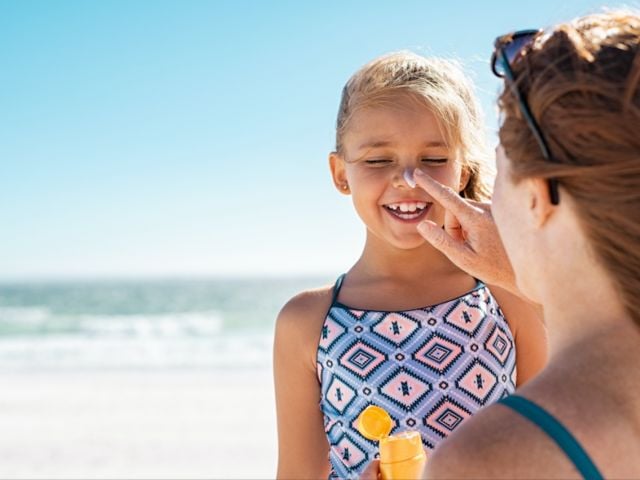
I keep a bottle of Banana Boat Sport SPF 100 on my desk.
But I am not convinced it deserves more than a SPF rating of 15, or maybe 30. As a chemist specializing in sunscreen chemicals, I run a sunscreen model that estimates, based on the active ingredients in the bottle, what a sunscreen product’s Sunburn Protection Factor ought to show.
So how can this stuff rate SPF 100. Is that possible?
Yes, the lotion in the bottle could, in controlled laboratory conditions, prevent what we think of as sunburn – red, painful skin. To claim SPF 100, the maker must put the product through tests approved by the federal Food and Drug Administration. These test must show it prevents skin redness to an extraordinary degree.
But no, it’s highly doubtful that this stuff could offer you as much protection as implied by the SPF 100 rating. SPF is an outdated, subjective concept, based on when a person’s skin starts to turn red. The tests can be gamed, and it’s safe to say that normal people do not use sunscreen in test conditions – applying sunscreen before blasting themselves with high-intensity, indoor UV lights.
Still, we need some kind of metric to determine the effectiveness of these products. Until the FDA updates testing requirements, manufacturers must use SPF numbers to convey, very roughly, how protective the product is, compared to its competitors.
But the truth is, preventing redness shouldn’t be the only measure of success. Sun damage, not redness, is the real enemy. While sunburn is not your friend, skin warmth and redness serve as your body’s early warning signs of sun damage. Redness is the body’s way of warning us that the sun’s rays are causing subtle, lasting changes in the skin’s cellular structure. These changes hasten wrinkling, sagging and other signs of aging, and may lead to cancer.
What if you couldn’t feel or see a fire burning your hand? You might stick your whole hand into the flames and get badly injured and scarred before you realized what was happening. Well, the sun literally burns skin too, but damage can occur at a slower pace.
Besides, the sun’s short ultraviolet B rays burn the skin’s surface, but longer ultraviolet A rays usually don’t. Little was known about UVA rays when the SPF system was created; now we know that UVA rays penetrate deeper into the body and may inflict similar or even more profound damage than UVB rays.
If you want protection from UVA rays – and believe me, you do – look for a sunscreen lotion whose label shows that it contains zinc oxide or 3 percent avobenzone. A 25 percent concentration of zinc oxide and a 3 percent concentration of avobenzone are the legal limits for these chemicals, and they are often used at, or near, those upper limits in SPF 30 products.
Sunscreen makers have a powerful incentive to jack up the SPF because people are conditioned to look for SPF numbers that relate to redness. To the sunscreen industry, high SPF means more sales and bigger profits. If you’ve bought sunscreen recently, you will have noticed that manufacturers are in an arms race to advertise astronomical SPF ratings.
Here’s the dirty little secret: Some sunscreen makers, and the companies that sell them ingredients, have developed numerous, well-documented ways to game the SPF tests to get a higher number on the tests without providing evidence that a product protects users from any other UV-related damages.
One method is to add anti-inflammatory and antioxidant chemicals into the mix. The SPF 100 sunscreen on my desk contains several chemicals in these categories: butyloctyl salicylate, aloe, vitamin C and vitamin E. Other anti-inflammmatories and antioxidants often found in sunscreen include bisabolol, retinyl palmitate and argan oil. While antioxidants and anti-inflammatories may serve other functions, they also likely reduce skin redness, thereby enabling the manufacturer to achieve a coveted high SPF rating.
Scientists don’t know exactly how anti-inflammatories and antioxidants work within a sunscreen applied to the body. Nor do they fully understand the biological events that lead to long-term skin damage and cancer.
But we’re sure about two things:
- Those anti-inflammatories and antioxidants don’t reduce the amount of sunlight that hits the user’s skin; and
- The FDA urgently needs to investigate these and all other chemicals that manufacturers are adding to sunscreens. Are they tamping down redness and spoofing the body’s early warning system? If so, Americans have a right to know, fast.
That’s why EWG has written the FDA, urging a new, high-priority study of anti-inflammatories and antioxidants, and requesting that, in the meantime, the FDA bar SPF values greater than 50.
Most importantly, we want the FDA to change the way it allows manufacturers to test for SPF values so that the numbers mean what they say they mean – protection from the sun’s harmful rays.
People need to know that sunscreen products – whether they say SPF 15 or 1,500 – won’t completely protect them and may, in fact, mislead them into staying in the sun so long they hurt themselves.
I don’t have all the answers, but I know this: That bottle of SPF 100 is staying on my desk. When my wife and I take our kids to the beach, it’s not coming with us. We want real broad-spectrum skin protection, not just huge numbers.
And, by the way, we don't expect any sunscreen to shield our kids’ skin from all, or even the most harmful, rays. We glop on the sunscreen and reapply after swimming and every two hours, but we know that there’s no such thing as “sun block.” The FDA doesn’t let sunscreen makers use the term “block” anymore.
Until the FDA takes further action, the most important things in our beach bags will be umbrellas, hats, shirts and long beach shorts.



